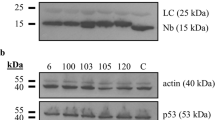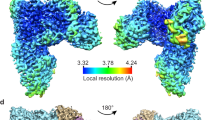Abstract
Mucosal human papillomaviruses (HPVs) are the causative agents of a number of human pathologies, including benign condylomas, as well as of the majority of cervical cancers and their high-grade precursor lesions. Although the viral E6 protein is known to be essential for driving malignant progression of HPV-infected cells, there are still many uncertainties about its mode of action. In this study, we have analysed the intracellular distribution of the E6 oncoproteins from the high-risk HPV-18 and the low-risk HPV-11. We show that both E6 proteins localize within the nucleus in nuclear bodies that are confocal with the promyelocytic leukaemia (PML) protein. Using a panel of different PML isoforms, we demonstrate specific co-localization between the E6 proteins and PML isoforms I–IV, but not with PML isoforms V and VI. We also demonstrate the interaction between E6 and a subset of PML isoforms in vivo. As a consequence of this interaction, the insoluble form of PML IV is destabilized by HPV-18 E6 through a proteasome-dependent pathway. Interestingly, both HPV-11 E6 and HPV-18 E6 can readily overcome PML IV-induced cellular senescence in primary cells. These results show separable functions for different PML isoforms that are specifically targeted by the HPV E6 oncoproteins.
This is a preview of subscription content, access via your institution
Access options
Subscribe to this journal
Receive 50 print issues and online access
$259.00 per year
only $5.18 per issue
Buy this article
- Purchase on Springer Link
- Instant access to full article PDF
Prices may be subject to local taxes which are calculated during checkout








Similar content being viewed by others
References
Ahn JH, Brignole III EJ and Hayward GS . (1998). Mol. Cell. Biol., 18, 4899–4913.
Ahn JH and Hayward GS . (1997). J. Virol., 71, 4599–4613.
Alcalay M, Tomassoni L, Colombo E, Stoldt S, Grignani F, Fagioli M, Szekely L, Helin K and Pelicci PG . (1998). Mol. Cell. Biol., 18, 1084–1093.
Alcalay M, Zangrilli D, Fagioli M, Pandolfi PP, Mencarelli A, Lo Coco F, Biondi A, Grignani F and Pelicci PG . (1992). Proc. Natl. Acad. Sci. USA, 89, 4840–4844.
Alvarez-Salas LM, Cullinan AE, Siwkowski A, Hampel A and DiPaolo JA . (1998). Proc. Natl. Acad. Sci. USA, 95, 1189–1194.
Androphy EJ, Hubbert NL, Schiller JT and Lowy DR . (1987). EMBO J., 6, 989–992.
Banks L, Spence P, Androphy E, Hubbert N, Matlashewski G, Murray A and Crawford L . (1987). J. Gen. Virol., 68 (Pt 5), 1351–1359.
Barbosa MS and Schlegel R . (1989). Oncogene, 4, 1529–1532.
Becker KA, Florin L, Sapp C and Sapp M . (2003). Virology, 314, 161–167.
Bedell MA, Jones KH, Grossman SR and Laimins LA . (1989). J. Virol., 63, 1247–1255.
Bischof O, Kirsh O, Pearson M, Itahana K, Pelicci PG and Dejean A . (2002). EMBO J., 21, 3358–3369.
Butz K, Denk C, Ullmann A, Scheffner M and Hoppe-Seyler F . (2000). Proc. Natl. Acad. Sci. USA, 97, 6693–6697.
Chen Z and Chen SJ . (1992). Leuk. Lymphoma, 8, 253–260.
Day PM, Roden RB, Lowy DR and Schiller JT . (1998). J. Virol., 72, 142–150.
Dimri GP, Lee X, Basile G, Acosta M, Scott G, Roskelley C, Medrano EE, Linskens M, Rubelj I, Pereira-Smith O, Peacocke M and Campisi J . (1995). Proc. Natl. Acad. Sci. USA, 92, 9363–9367.
DiPaolo JA, Burkhardt A, Doniger J, Pirisi L, Popescu NC and Yasumoto S . (1986). Toxicol. Pathol., 14, 417–423.
Duprez E, Saurin AJ, Desterro JM, Lallemand-Breitenbach V, Howe K, Boddy MN, Solomon E, de The H, Hay RT and Freemont PS . (1999). J. Cell Sci., 112 (Part 3), 381–393.
Durst M, Dzarlieva-Petrusevska RT, Boukamp P, Fusenig NE and Gissmann L . (1987). Oncogene, 1, 251–256.
Dyck JA, Maul GG, Miller Jr WH, Chen JD, Kakizuka A and Evans RM . (1994). Cell, 76, 333–343.
Everett RD, Freemont P, Saitoh H, Dasso M, Orr A, Kathoria M and Parkinson J . (1998). J. Virol., 72, 6581–6591.
Everett RD and Maul GG . (1994). EMBO J., 13, 5062–5069.
Ferbeyre G, de Stanchina E, Querido E, Baptiste N, Prives C and Lowe SW . (2000). Genes Dev., 14, 2015–2027.
Florin L, Sapp C, Streeck RE and Sapp M . (2002a). J. Virol., 76, 10009–10014.
Florin L, Schafer F, Sotlar K, Streeck RE and Sapp M . (2002b). Virology, 295, 97–107.
Fogal V, Gostissa M, Sandy P, Zacchi P, Sternsdorf T, Jensen K, Pandolfi PP, Will H, Schneider C and Del Sal G . (2000). EMBO J., 19, 6185–6195.
Goodwin EC, Yang E, Lee CJ, Lee HW, DiMaio D and Hwang ES . (2000). Proc. Natl. Acad. Sci. USA, 97, 10978–10983.
Gostissa M, Hengstermann A, Fogal V, Sandy P, Schwarz SE, Scheffner M and Del Sal G . (1999). EMBO J., 18, 6462–6471.
Guccione E, Massimi P, Bernat A and Banks L . (2002). Virology, 293, 20–25.
Heino P, Zhou J and Lambert PF . (2000). Virology, 276, 304–314.
Ishov AM, Vladimirova OV and Maul GG . (2002). J. Virol., 76, 7705–7712.
Jang MS, Ryu SW and Kim E . (2002). Biochem. Biophys. Res. Commun., 295, 495–500.
Jensen K, Shiels C and Freemont PS . (2001). Oncogene, 20, 7223–7233.
Jiang M and Milner J . (2002). Oncogene, 21, 6041–6048.
Kamitani T, Kito K, Nguyen HP, Wada H, Fukuda-Kamitani T and Yeh ET . (1998). J. Biol. Chem., 273, 26675–26682.
Kanda T, Watanabe S and Yoshiike K . (1988). Virology, 165, 321–325.
Lallemand-Breitenbach V, Zhu J, Puvion F, Koken M, Honore N, Doubeikovsky A, Duprez E, Pandolfi PP, Puvion E, Freemont P and de The H . (2001). J. Exp. Med., 193, 1361–1371.
LaMorte VJ, Dyck JA, Ochs RL and Evans RM . (1998). Proc. Natl. Acad. Sci. USA, 95, 4991–4996.
Li H and Chen JD . (2000). Curr. Opin. Cell Biol., 12, 641–644.
Mantovani F and Banks L . (2001). Oncogene, 20, 7874–7887.
Muller S and Dejean A . (1999). J. Virol., 73, 5137–5143.
Munger K, Basile JR, Duensing S, Eichten A, Gonzalez SL, Grace M and Zacny VL . (2001). Oncogene, 20, 7888–7898.
Munger K, Phelps WC, Bubb V, Howley PM and Schlegel R . (1989). J. Virol., 63, 4417–4421.
Muratani M, Gerlich D, Janicki SM, Gebhard M, Eils R and Spector DL . (2002). Nat. Cell Biol., 4, 106–110.
Pearson M, Carbone R, Sebastiani C, Cioce M, Fagioli M, Saito S, Higashimoto Y, Appella E, Minucci S, Pandolfi PP and Pelicci PG . (2000). Nature, 406, 207–210.
Pim D, Massimi P and Banks L . (1997). Oncogene, 15, 257–264.
Pearson M and Pelicci PG . (2001). Oncogene, 20, 7250–7256.
Rodriguez MS, Dargemont C and Hay RT . (2001). J. Biol. Chem., 276, 12654–12659.
Schwarz E, Freese UK, Gissmann L, Mayer W, Roggenbuck B, Stremlau A and zur Hausen H . (1985). Nature, 314, 111–114.
Sedman SA, Barbosa MS, Vass WC, Hubbert NL, Haas JA, Lowy DR and Schiller JT . (1991). J. Virol., 65, 4860–4866.
Sternsdorf T, Jensen K and Will H . (1997). J. Cell Biol., 139, 1621–1634.
Swindle CS, Zou N, Van Tine BA, Shaw GM, Engler JA and Chow LT . (1999). J. Virol., 73, 1001–1009.
Torii S, Egan DA, Evans RA and Reed JC . (1999). EMBO J., 18, 6037–6049.
von Knebel Doeberitz M, Rittmuller C, zur Hausen H and Durst M . (1992). Int. J. Cancer, 51, 831–834.
Vousden KH, Doniger J, DiPaolo JA and Lowy DR . (1988). Oncogene Res., 3, 167–175.
Wells SI, Francis DA, Karpova AY, Dowhanick JJ, Benson JD and Howley PM . (2000). EMBO J., 19, 5762–5771.
Wiesmeijer K, Molenaar C, Bekeer IM, Tanke HJ and Dirks RW . (2002). J. Struct. Biol., 140, 180–188.
Wigler M, Sweet R, Sim GK, Wold B, Pellicer A, Lacy E, Maniatis T, Silverstein S and Axel R . (1979). Cell, 16, 777–785.
Wu WS, Vallian S, Seto E, Yang WM, Edmondson D, Roth S and Chang KS . (2001). Mol. Cell Biol., 21, 2259–2268.
Zhong S, Muller S, Ronchetti S, Freemont PS, Dejean A and Pandolfi PP . (2000). Blood, 95, 2748–2752.
zur Hausen H . (1987). Appl. Pathol., 5, 19–24.
zur Hausen H . (2000). J. Natl. Cancer Inst., 92, 690–698.
Acknowledgements
This work was supported in part by research grants from the Associazione Italiana per la Ricerca sul Cancro to LB and from the Biotechnology and Biological Sciences Research Council (UK) to KNL. We gratefully acknowledge the gift of cDNA clones for PMLIV from R Everett (Inst. of Virology, Glasgow), for PML I, II and VI from E Solomon (Guys Hospital, London), for PML I, II, IV and V from PG Pelicci (European Institute of Oncology, Milan) and for PML III from A Dejean (Inst. Pasteur, Paris). We are also grateful to G Del Sal and PP Pandolfi for the gift of PML−/− fibroblasts, and to Miranda Thomas and David Pim for comments on the manuscript.
Author information
Authors and Affiliations
Corresponding author
Rights and permissions
About this article
Cite this article
Guccione, E., Lethbridge, K., Killick, N. et al. HPV E6 proteins interact with specific PML isoforms and allow distinctions to be made between different POD structures. Oncogene 23, 4662–4672 (2004). https://doi.org/10.1038/sj.onc.1207631
Received:
Revised:
Accepted:
Published:
Issue Date:
DOI: https://doi.org/10.1038/sj.onc.1207631
Keywords
This article is cited by
-
Distribution and location of Daxx in cervical epithelial cells with high risk human papillomavirus positive
Diagnostic Pathology (2014)
-
SUMO modification of E1B-55K oncoprotein regulates isoform-specific binding to the tumour suppressor protein PML
Oncogene (2010)
-
E6AP promotes the degradation of the PML tumor suppressor
Cell Death & Differentiation (2009)



